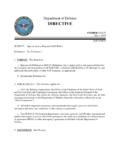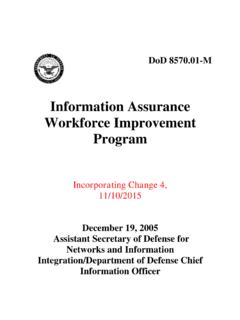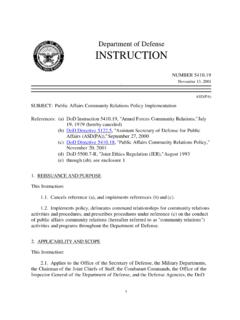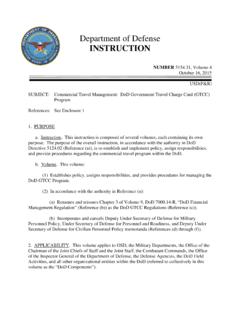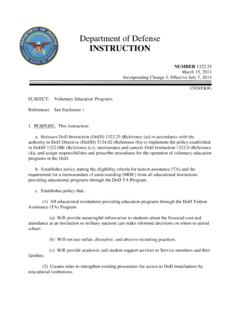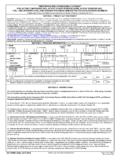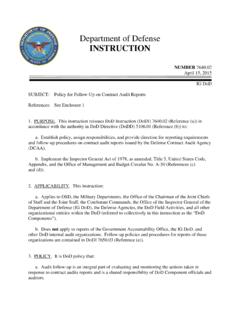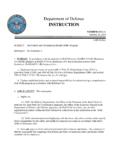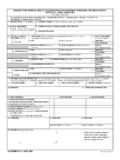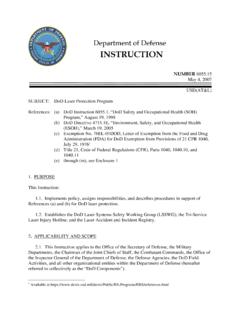Transcription of Department of Defense INSTRUCTION
1 Department of Defense INSTRUCTION . NUMBER March 14, 2014. DoD CIO. SUBJECT: Cybersecurity References: See Enclosure 1. 1. PURPOSE. This INSTRUCTION : a. Reissues and renames DoD Directive (DoDD) (Reference (a)) as a DoD. INSTRUCTION (DoDI) pursuant to the authority in DoDD (Reference (b)) to establish a DoD cybersecurity program to protect and defend DoD information and information technology (IT). b. Incorporates and cancels DoDI (Reference (c)), DoDD (Reference (d)), DoDI (Reference (e)), Assistant Secretary of Defense for Networks and Information Integration (ASD(NII))/DoD Chief Information Officer (DoD CIO) Memorandums (References (f) through (k)), and Directive-type Memorandum (DTM) 08-060 (Reference (l)). c. Establishes the positions of DoD principal authorizing official (PAO) (formerly known as principal accrediting authority) and the DoD Senior Information Security Officer (SISO).
2 (formerly known as the Senior Information Assurance Officer) and continues the DoD. Information Security Risk Management Committee (DoD ISRMC) (formerly known as the Defense Information Systems Network (DISN)/Global Information Grid (GIG) Flag Panel). d. Adopts the term cybersecurity as it is defined in National Security Presidential Directive-54/Homeland Security Presidential Directive-23 (Reference (m)) to be used throughout DoD instead of the term information assurance (IA).. 2. APPLICABILITY. a. This INSTRUCTION applies to: (1) OSD, the Military Departments, the Office of the Chairman of the Joint Chiefs of Staff (CJCS) and the Joint Staff, the Combatant Commands, the Office of the Inspector General of the DoD, the Defense Agencies, the DoD Field Activities, and all other organizational entities within the DoD (referred to collectively in this INSTRUCTION as the DoD Components ).
3 DoDI , March 14, 2014. (2) All DoD IT. (3) All DoD information in electronic format. (4) Special access program (SAP) information technology, other than SAP ISs handling sensitive compartmented information (SCI) material. b. Nothing in this INSTRUCTION alters or supersedes the existing authorities and policies of the Director of National Intelligence (DNI) regarding the protection of SCI as directed by Executive Order 12333 (Reference (n)) and other laws and regulations. 3. POLICY. It is DoD policy that: a. Risk Management (1) DoD will implement a multi-tiered cybersecurity risk management process to protect interests, DoD operational capabilities, and DoD individuals, organizations, and assets from the DoD Information Enterprise level, through the DoD Component level, down to the IS level as described in National Institute of Standards and Technology (NIST) Special Publication (SP).
4 800-39 (Reference (o)) and Committee on National Security Systems (CNSS) Policy (CNSSP). 22 (Reference (p)). (2) Risks associated with vulnerabilities inherent in IT, global sourcing and distribution, and adversary threats to DoD use of cyberspace must be considered in DoD employment of capabilities to achieve objectives in military, intelligence, and business operations. (3) All DoD IT will be assigned to, and governed by, a DoD Component cybersecurity program that manages risk commensurate with the importance of supported missions and the value of potentially affected information or assets. (4) Risk management will be addressed as early as possible in the acquisition of IT and in an integrated manner across the IT life cycle. (5) Documentation regarding the security posture of DoD IS and PIT systems will be made available to promote reciprocity as described in DoDI (Reference (q)) and to assist authorizing officials (AOs) (formerly known as designated approving or accrediting authorities).
5 From other organizations in making credible, risk-based decisions regarding the acceptance and use of systems and the information that they process, store, or transmit. b. Operational Resilience. DoD IT will be planned, developed, tested, implemented, evaluated, and operated to ensure that: (1) Information and services are available to authorized users whenever and wherever required according to mission needs, priorities, and changing roles and responsibilities. 2. DoDI , March 14, 2014. (2) Security posture, from individual device or software object to aggregated systems of systems, is sensed, correlated, and made visible to mission owners, network operators, and to the DoD Information Enterprise consistent with DoDD (Reference (r)). (3) Whenever possible, technology components ( , hardware and software) have the ability to reconfigure, optimize, self-defend, and recover with little or no human intervention.
6 Attempts made to reconfigure, self-defend, and recover should produce an incident audit trail. c. Integration and Interoperability (1) Cybersecurity must be fully integrated into system life cycles and will be a visible element of organizational, joint, and DoD Component IT portfolios. (2) Interoperability will be achieved through adherence to DoD architecture principles, adopting a standards-based approach, and by all DoD Components sharing the level of risk necessary to achieve mission success. (3) All interconnections of DoD IT will be managed to minimize shared risk by ensuring that the security posture of one system is not undermined by vulnerabilities of interconnected systems. d. Cyberspace Defense . Cyberspace Defense will be employed to protect, detect, characterize, counter, and mitigate unauthorized activity and vulnerabilities on DoD information networks.
7 Cyberspace Defense information will be shared with all appropriately cleared and authorized personnel in support of DoD enterprise-wide situational awareness. e. Performance (1) Implementation of cybersecurity will be overseen and governed through the integrated decision structures and processes described in this INSTRUCTION . (2) Performance will be measured, assessed for effectiveness, and managed relative to contributions to mission outcomes and strategic goals and objectives, in accordance with Sections 11103 and 11313 of Title 40, United States Code ( ) (Reference (s)). (3) Data will be collected to support reporting and cybersecurity management activities across the system life cycle. (4) Standardized IT tools, methods, and processes will be used to the greatest extent possible to eliminate duplicate costs and to focus resources on creating technologically mature and verified solutions.
8 F. DoD Information. All DoD information in electronic format will be given an appropriate level of confidentiality, integrity, and availability that reflects the importance of both information sharing and protection. 3. DoDI , March 14, 2014. g. Identity Assurance (1) Identity assurance must be used to ensure strong identification, authentication, and eliminate anonymity in DoD IS and PIT systems. (2) DoD will public key-enable DoD ISs and implement a DoD-wide Public Key Infrastructure (PKI) solution that will be managed by the DoD PKI Program Management Office in accordance with DoDI (Reference (t)). (3) Biometrics used in support of identity assurance will be managed in accordance with DoDD (Reference (u)). h. Information Technology (1) All IT that receives, processes, stores, displays, or transmits DoD information will be acquired, configured, operated, maintained, and disposed of consistent with applicable DoD.
9 Cybersecurity policies, standards, and architectures. (2) Risks associated with global sourcing and distribution, weaknesses or flaws inherent in the IT, and vulnerabilities introduced through faulty design, configuration, or use will be managed, mitigated, and monitored as appropriate. (3) Cybersecurity requirements must be identified and included throughout the lifecycle of systems including acquisition, design, development, developmental testing, operational testing, integration, implementation, operation, upgrade, or replacement of all DoD IT supporting DoD tasks and missions. i. Cybersecurity Workforce (1) Cybersecurity workforce functions must be identified and managed, and personnel performing cybersecurity functions will be appropriately screened in accordance with this INSTRUCTION and DoD (Reference (v)), and qualified in accordance with DoDD (Reference (w)) and supporting issuances.
10 (2) Qualified cybersecurity personnel must be identified and integrated into all phases of the system development life cycle. j. Mission Partners (1) Capabilities built to support cybersecurity objectives that are shared with mission partners will be consistent with guidance contained in Reference (r) and governed through integrated decision structures and processes described in this INSTRUCTION . 4. DoDI , March 14, 2014. (2) DoD-originated and DoD-provided information residing on mission partner ISs must be properly and adequately safeguarded, with documented agreements indicating required levels of protection. 4. RESPONSIBILITIES. See Enclosure 2. 5. PROCEDURES. See Enclosure 3. 6. INFORMATION COLLECTION REQUIREMENTS. The DoD Federal Information Security Management Act (FISMA) Annual Report with Quarterly Updates, referred to in paragraphs 1v and 13q of Enclosure 2 and paragraph 12i of Enclosure 3 of this INSTRUCTION , has been assigned report control symbol DD-CIO(A,Q)2296 in accordance with the procedures in DTM 12-004 (Reference (x)) and DoD (Reference (y)).
